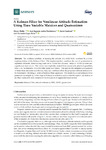A Kalman Filter for Nonlinear Attitude Estimation Using Time Variable Matrices and Quaternions

View/
Use this link to cite
http://hdl.handle.net/2183/27218Collections
- Investigación (EPEF) [590]
Metadata
Show full item recordTitle
A Kalman Filter for Nonlinear Attitude Estimation Using Time Variable Matrices and QuaternionsDate
2020Citation
Deibe, Á.; Antón Nacimiento, J.A.; Cardenal, J.; López Peña, F. A Kalman Filter for Nonlinear Attitude Estimation Using Time Variable Matrices and Quaternions. Sensors 2020, 20, 6731. https://doi.org/10.3390/s20236731
Abstract
[Abstract] The nonlinear problem of sensing the attitude of a solid body is solved by a novel implementation of the Kalman Filter. This implementation combines the use of quaternions to represent attitudes, time-varying matrices to model the dynamic behavior of the process and a particular state vector. This vector was explicitly created from measurable physical quantities, which can be estimated from the filter input and output. The specifically designed arrangement of these three elements and the way they are combined allow the proposed attitude estimator to be formulated following a classical Kalman Filter approach. The result is a novel estimator that preserves the simplicity of the original Kalman formulation and avoids the explicit calculation of Jacobian matrices in each iteration or the evaluation of augmented state vectors.
Keywords
Kalman, Filtro de
Cuaterniones
Sensores de desplazamiento
Kalman filter
Attitude estimation
IMU
AHRS
Quaternions
Cuaterniones
Sensores de desplazamiento
Kalman filter
Attitude estimation
IMU
AHRS
Quaternions
Editor version
Rights
Atribución 4.0
ISSN
1424-8220






